| 1 | The top burrowing kingsnake |
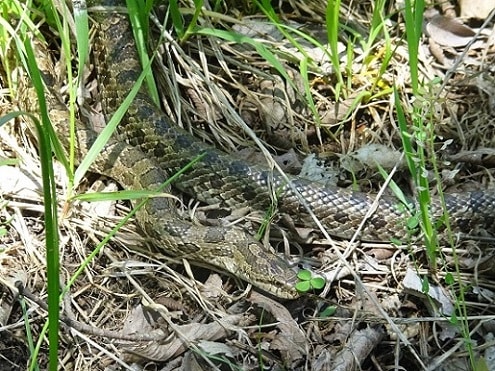
The US has over 15 kingsnake species, spread from west coast to east, and crossing the border deep into Mexico. The prairie kingsnake dwells in the central US, and is particularly abundant in Kansas, Arkansas, Missouri, southern Iowa and southern Illinois. This species has similarities to its brethren, being a medium length (75-125cm) constrictor which lacks any form of venom. Prairie kingsnakes have never killed anyone and are safe to pick up, with a relatively docile personality.
The difference with this species is its underground habits. Prairie kingsnakes spend over 70% of their time in underground burrows, often a vole burrow after swallowing the owner. This is a nocturnal species which moves on the surface by night, and stashes itself away during daylight. Its main habitats are grassy fields and spacious woodlands, meaning that this is a classic species which you might walk past without knowing. You could be mere feet from a prairie kingsnake while walking your dog through a grassy field, and have no clue. You may have stepped on the earth directly above its hidey hole, causing a shower of soil particles to fall on its head.
Prairie kingsnakes are never found in forests, nor urban areas. They need relatively open grassy expanses, with soft soil that small mammals that can easily dig into. They also stick to the ground, and rarely climb trees. Prairie kingsnakes have decent burrowing capabilities, shifting aside loose soil to enlarge an entrance.
| 2 | The brownest, greyest kingsnake |
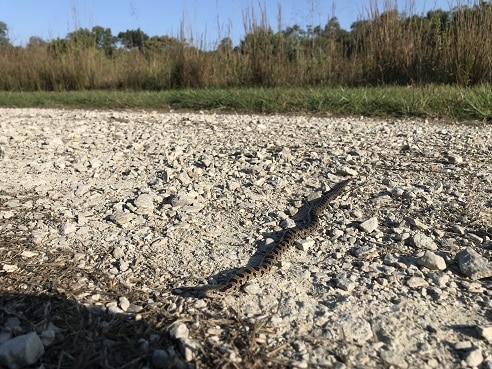
Prairie kingsnakes are a relatively easy species to identify. Their territory overlaps with three other kingsnakes, in the central USA, but common kingsnakes are black with occasional yellow or white stripes. Milk snakes have a coral snake mimicking pattern: red, white and black stripes. Speckled kingsnakes are speckled. Meanwhile, prairie kingsnakes are brown with lighter brown or copper red blotches.
As for other snakes, prairie kingsnakes are sometimes confused with copperheads and beaten to death out of fear, but they’re easily distinguishable. Copperheads have a handful of huge, hourglass-shaped blotches. Prairie kingsnakes have dozens of smaller blotches, as many as 70.
Prairie kingsnakes have round pupils, and a moderately thick body, being a constrictor. Juveniles have more sharply contrasting patterns. With age, this species sometimes fades to a uniform brown, with faint markings being barely visible. At 75-125cm, Lampropeltis calligaster is medium for the kingsnake family. Males are slightly longer than females. This is a species where males will wrestle for dominance, to gain female affections, and snake species with male wrestling have a correlation with males being longer. The longest prairie kingsnake of all time was discovered in Edmonson County, Kentucky, under a large sheet of metal, in May 2005. After taking care not to stretch it, researchers measured the kingsnake at 143cm. It weight was 673.6 grams.
| 3 | Habitat: prefers open grassy fields |
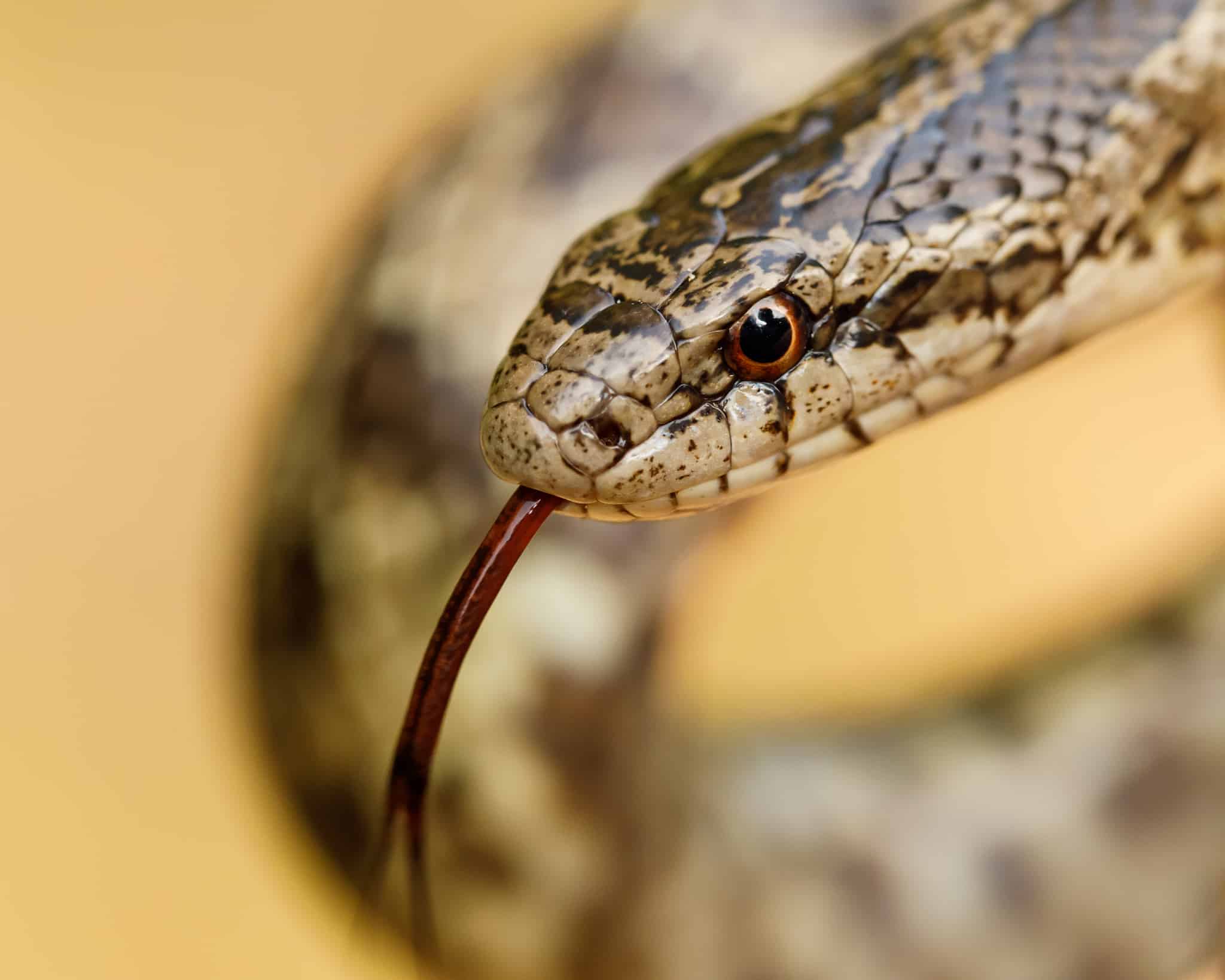
It’s been known for years that prairie kingsnakes lurk underground, more so than California kingsnakes or common kingsnakes. In 2006, a study decided to prove it. It implanted radio trackers into 10 prairie kingsnakes, 6 male and 4 female, in the countryside of Illinois. They were followed for a complete active season, from April to October, in a mixed area of roads, agriculture, grassy fields and woods.
The prairie kingsnakes were relocated 574 times, and of those, 73% of readings were underground. The kingsnakes almost completely avoided agricultural fields. Something about swaying rows of wheat or corn were intolerable to them. Their favourite habitats were grassy fields, and the margins of grassy fields by roads.
Unlike a corn snake, the prairie kingsnakes never crossed roads. The borders of their territories were often demarcated by a road itself. The only kingsnake to cross a road actually used a small creek below it. This is both good and bad: protection against the grisly fate of roadkill (common with corn snakes), but also a barrier to migration, possibly causing their territory to fragment.
| 4 | Hides in empty mole burrows |
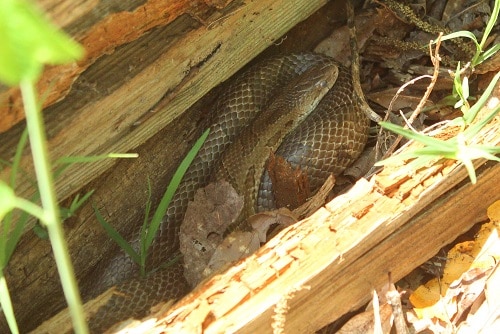
Males and females were compared in the study. The two had similar activity levels over the 5+ months, with similar distances per movement and number of movements. But males had a home range 4 times larger, prowling around a far larger territory. Their territory measured 1.8-14.8 hectares versus 1.3-3.5 hectares for females.
Meanwhile, an older 1979 study found that males roam an area 2.46 larger than females. This study took place in Harvey County, south central Kansas, and the University of Kansas Natural History Reservation. The study also analysed their distance moved per day. 25 kingsnakes were marked and tracked, while a further 2 were implanted with radio trackers. These snakes were recaptured 9 days to 46 months later, some being recaptured more than once. The distances from the original point ranged from 18.3 to over 700 metres. The average distance between successive capture points for males was 265 metres, and 169 metres for females. The male average was excluding one extremely large migration of 764 metres.
Obviously, some kingsnakes took longer to be recaptured, thus explaining the longer distances. But it still shows that this snake isn’t limited to a tiny area like some burrow dwellers are. Prairie kingsnakes are a weird species ; a lazy underground snake for 70% of the time, but capable of revving up and exploring, like the California kingsnake out west (another energetic species). When resting, the two radiotracked kingsnakes were found in burrows of the prairie vole (Microtus ochrogaster) and eastern mole (Scalopus aquaticus), or simply lurking beneath mats of dead vegettion.
| 5 | Preys mainly on mammals |
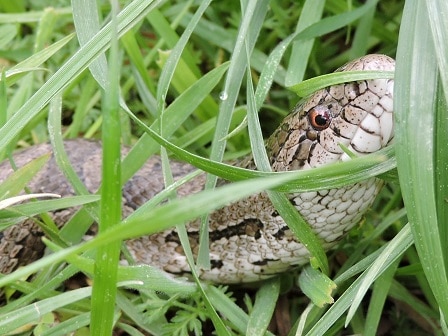
Prairie kingsnakes eats the usual basic menu of prey for a kingsnake: mammals, reptiles and fellow snakes. But compared to their cousins, prairie kingsnakes are tilted far further towards mammals, partly as a consequence of hanging out in their burrows, swallowing them up before settling down to rest.
A 2019 study examined a huge number of prairie kingsnakes, with 1337 taken from over 10 natural history museum collections. 169 (12.6%) of the snakes had prey in their bellies, preserved for years in storage. The breakdown was as follows: mammals at 69.8%, reptiles at 24.3%, and birds at 1.2%. The remaining 4.7% were unidentifiable mush.
Meanwhile, the Kansas study identified a total of 66 prey items. Mammals were overwhelmingly the majority, and one species was particularly common: the prairie vole (Microtus ochrogaster), recorded as prey 30 times. This brown, widespread creature lives in the central USA, and is also confirmed prey of the prairie rattlesnake. It has brown fur and a short lifespan of 1-2 years, not surprisingly given all the snakes on its tail.
| 6 | Top prey: voles and shrews |
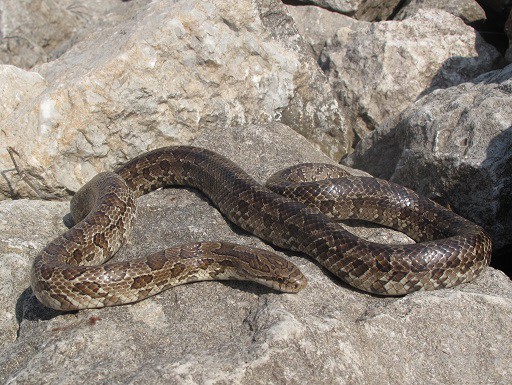
In joint second place were the eastern mole (Scalopus aquaticus), and a reptile, the six-lined racerunner (Cnemidophorus sexlineatus). This was followed by the northern short-tailed shrew and white-footed mouse. Small, scurrying mammals are undoubtedly the prairie kingsnake’s favourite prey, with a smattering of reptile eggs as well. Using weight, prairie voles made up an estimated 48% of prey, with eastern moles contributing 24%.
Yet another study reached the same conclusion. This took place in Iowa in 1959, and analysed 140 Lampropeltis calligaster in total. It was a familiar story: 68.6% mammals and 6.8% reptiles. Several species made a return, including the woodland vole (M. pinetorum) and eastern mole. The top species was again the prairie vole, which contributed 70 individual prey, followed by the ubiquitous house mouse at 39 prey.
Prairie kingsnakes have similar tastes across their vast US territory. But this study had subtle differences too, Amphibians made up 11.2% of prey, and there was a helping of insects (6.4%), while no insects were found in the Kansas study. 50 members of the Orthopterans family (grasshoppers, crickets) were found, alongside 6 beetles.
| 7 | Snakes are on the menu |
Prairie rattlesnakes eat snakes far less commonly than California kingsnakes, but will indulge as an occasional snack. In the Kansas study, a prairie rattlesnake ate an eastern racer (Coluber constrictor) it was sharing a shelter with. Two eastern racers were recorded as prey overall. A large male ate a hatchling timber rattlesnake, showing that they possess the venom resistance of California kingsnakes, even if they use it less commonly. Other confirmed meals are worm snakes (Carphophis amoenus), and milk snakes.
Some snakes attempt to defend themselves. A 1975 study found that Crotalids, such as prairie rattlesnakes and copperheads, perform a “body bridging” trick where they arch their mid section upwards, probably to distract from the head. They performed this trick in response to prairie kingsnake and common kingsnake scents, recognising a potential predator. However, they didn’t react to milk snakes (Lampropeltis triangulum), which are very short for kingsnakes, and probably incapable of eating rattlesnakes.
By entering this snake civil war, prairie kingsnakes also suffer the side effects. Their own confirmed predators include eastern coral snakes and milk snakes.
| 8 | Hibernates alongside other snakes |
Lurking in burrows gives prairie kingsnakes another advantage; automatic hibernation dens. The study from northeast Kansas found that many local snake species migrated to rocky limestone outcrops in the winter, to hibernate in cracks: copperheads, black ratsnakes, pine snakes, timber rattlesnakes. While some prairie kingsnakes migrated to the outcrops, more chose to remain in their grassy fields, hibernating in a cosy burrow which they’d scoped out months beforehand.
While there’s subtle differences around the edges, Lampropeltis calligaster is a committed mammal-muncher at heart. The Kansas study also revealed how they live mostly in harmony with other snakes, revealing an entire mini snake society. The study area on the Kansas University Reserve (northeastern Kansas) contained a grand total of 16 snake species. Somehow they were able to coexist without wiping each other out.
Prairie kingsnakes were the 8th most abundant species, with just 0.1% of the numbers of the most abundant, the ringneck snake. This 30cm species is notorious for gathering together under sheet metal and rotting logs in vast numbers. Prairie kingsnakes were the 5th largest nearby, beaten by the pine snake.
| 9 | Unbeatable in its niche |
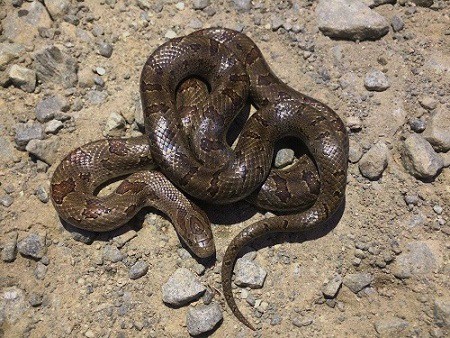
One by one, the prairie kingsnake’s neighbours had characteristics that made them non-competitive. The first niche was snakes which were far smaller, and mainly fed on insects and worms, including eastern worm snakes, ringneck snakes, flat-headed snakes, and DeKay’s brown snakes. Two local snakes had a diet heavy in fish and frogs: common garter snakes and northern watersnakes. This already eliminated a swathe from being direct competitors.
Pine snakes were also mammal-munchers, but with their large size, leaned towards larger prey like rabbits rather than voles. Copperheads and timber rattlesnakes ate a variety of mammals, but tended to inhabit forests, which prairie kingsnakes avoid. Corn snakes and black ratsnakes are skilful tree climbers and commonly raid bird’s nests.
Two fellow kingsnakes lived nearby: the milk snake (mainly a lizard eater) and the common kingsnake (more reliant on snakes). All in all, this left the prairie kingsnake with a comfortable niche: a grassy field dweller which primarily eats small mammals, and hangs out in their burrows. The last two snakes in the mini community were the smooth earth snake and eastern racer.
| 10 | Divided in three species |
In the last 10 years, the three former prairie kingsnake subspecies have been split into independent species, and its territory is now reduced. These days, the prairie kingsnake is the most common and westernmost species of the subgroup. Its southernmost point is the deep south of Texas, and its northernmost point southern Iowa and Illinois. Hotspots include Kansas, Arkansas, Missouri and Oklahoma.
The mole kingsnake (Lampropeltis rhombomaculata), a former subspecies, lives exclusively east of the Mississippi river, reaching the Florida panhandle. The yellow-bellied kingsnake (Lampropeltis occipitolineata) inhabits southern Florida. The three have similar underground lifestyles, mainly varying by subtle patterns and scale counts. For example, Lampropeltis occipitolineata has over 75 blotches, versus less than 72 for the others.
But to a layman, they’re very difficult to distinguish, and behave like the same creature. There may be subtle diet differences which haven’t been discovered, like a tendency towards insects in southern Florida, as a random possibility.
